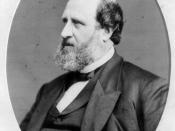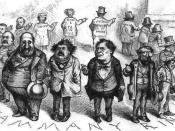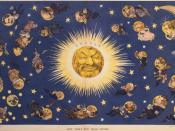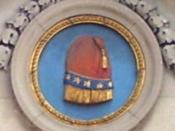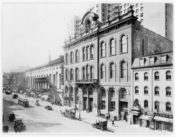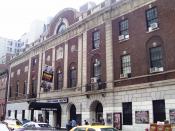?Did William M. Tweed Corrupt Post-Civil War New York?? Many people have there views on post Civil War New York, some like Alexander B. Callow Jr., say it was corrupt and run by William Tweed and the Tammany Hall gang. But other like Leo Hershkowitz have there own views on what it was like in New York after the Civil War, he thinks that all the bad and corrupt stuff was blamed on Tweed and his men because they were scapegoats. Many people think that this result of graft and theft, in the post Civil Warcity of New York was the consequence of what they called ?Machine Politics?. This ?machine politics? is characterized by a disciplined and hierarchical organization, reaching down to neighborhood and block organizers that enables the machine to respond to the problems of individual neighborhoods, or even families, in exchange for loyalty at the polls. The term refers to their ability to elect candidates or enact measures with mechanical efficiency and predictability.
The ultimate goal of one of these political machines is to say in power, rather than to do what is best for the people.
Alexander B. Callow Jr. argues that by exercising corrupting influences over the city and state government, as well as over key elements within the business community, that Tweed and his infamous ?ring? extracted enormous sums of money from New York and used it for their own benefits and gains. Callow Jr. claims that Tammany hall gang lead by tweed was the biggest case of post-Civil War corruption in the United States, he says that Tweed had people working for him in just about every department in New York, that what ever he wanted he got. The city, the state, and the business community were the three vital sources controlled by Tweed. Callow Jr. says that Tweeds reputation, as a corrupt leader of the ?ring? was well deserved. Callow Jr. definition of a ?Ring? is that it encircles enough influential men in the organization of each party to control the action of both party machines; men who in public push to extremes the abstract ideas of their respective parties, while they secretly join their hands in schemes for personal power and profit (pg.96). The three sources Tweed controlled mentioned earlier, city, state and business community, were his main means of extracting money. The way he controlled the city was he had control of the key legislative and financial agencies like the Supervisors, Alderman, Comptroller, and Mayor. This gave the ?ring? command over New York?s financial machinery and plenty of opportunities for graft. Control over these thing meant that there was always someone somewhere to cover things up, if there was a mistake made. The ?ring? operated in a remarkably open and straightforward fashion says Callow Jr. (pg.98). This was because they had people everywhere that were involved. The money that the ?ring? stole from the city was divided up through out the ranks the higher you were in the ranks a bigger pre cent of the money you would get. The ?ring? had simple and easy plans when it came to stealing the money, they would do simple things like over charge, charge for jobs never completed and buy less quality products. According to Callow Jr. the way that Tweed created this ?ring? of people and stole all this money from the city, was a simple and easy plan, but little could be done about it because there was people everywhere to cover up and protect the leaders. They did this all for the money, and as long as the money was there they would do whatever they were told to do by the leaders. This is what made Tweed a criminal who corrupted all of New York according to Callow Jr.
The way that Leo Hershkowitz sees it is that ?Boss? Tweed was all a Myth that was made up. Just because he had the physical features of a crooked man, the whole scandal was pinned on him and his men. Hershkowitz isn?t saying that Tweed wasn?t totally innocence but it wasn?t all him leading the ?ring?. He say through fraud, deceit and intimidation, he was elected to various city and state offices, and even a term in congress (Pg.106). He met people whom he placed in strategic places as members of ?The Ring? to pillage the city treasury, conquer the state and finally the nation. Simply by using device of padded or fictitious bills for items not delivered or not needed, millions were stolen. Hershkowitz says that it would be impossible for one man or even a group of men to plan such a vast swindle involving hundreds if not thousands of officials, clerks, laborers, contractors, and hope to succeed. If Tweed plotted such an operation, which supposedly involved bribing the state legislature, coercing judges, muzzling the press, aborting the gossip of bank officers and city auditors, he must have been a genius or Houdini like (Pg.108). Hershkowitz goes on about how he thinks at no time did a ?ring? dominate New York City politics, let alone the state or national scene; these supposed ?ring? members rarely had much to do with each other. There was nothing to bind the so-called ?ring? members, just that they served in various city posts at the same time. The image of the ?Tammany Tiger? was plastered on Tweed and stuck with him. Hershkowitz talks about the good things that Tweed was responsible for on pg.111, he was credited for establishing legislative programs, which opened schools, hospitals, museums, and programs to meet the needs of a rapidly expanding constituency. His identification with the interests was enough for the traditional rural-suburban leadership to seek his destruction. One of these people was George Nast, who was a political cartoonist who disliked the ideas of Tweed and his men. So he would publish cartoons that depicted the ?ring? as corrupt and criminals. He and others did this because they saw Tweed as an outsider threatening their position. Tweed was never tried or found guilty of graft or theft, the crimes he stands accused of by history, he was convicted of a misdemeanor after some improper, even illegal judicial proceedings, which Hershkowitz thinks were worse than anything Tweed supposedly committed.
The outside article I chose about the Tweed Ring was an article on ?urban bosses and machine politics?; it was writing by Bruce M. Stave, it told how Tweed was the man who ran New York after the Civil War. That Tweed rose through the ranks of New York City, starting as the leader of a local volunteer fire company, then rising to alderman, and then finally to congressman. Then after two years of that he came back to New York and he accepted the job as commissioner of the Board of Education. He would go on to hold many other positions with the city, which able him to steal the money. This theft affected the city debt greatly. In 1867, the debt was $30 million; by 1871 the debt rose to $90 million. This article also says that in 1869 the "ring" met in Albany, and decided that ý of all the bills rendered to the city and county must be fraudulent. The money that was gained from padding the bills was to be divided into five parts. One part would go to each of the following: Tweed, Sweeny, Hall and Connolly, and the fifth part would go towards bribing smaller politicians. This let the main leaders of the ?ring? live a rich and luxurious life, even though many suspected them of some kind of wrongdoing. Eventually this graft and theft would catch up to Tweed and his men and the papers would expose them and the city bank would not give them any more credit. They tried to bribe the papers and media but they did not take the bribes. An attack was brought upon Tweed; the attack was to get him out of office. Although the newspapers had exposed the scandals of the ring, it was not enough to arrest Tweed on charges of theft. But he was arrested on a different charge of lesser extent. This sent Tweed to prison sometime later and disassembled the ?ring? sending some men scattering and some staying.
All of the articles were good in explaining their arguments, they all had good detail in how, and what they thought Tweed did, while he was in office. They all had significant evidence to back up their thoughts on what happened. I think that when you read about Tweed and His ?ring? that you get the assumption that he was crooked, even in the argument by Hershkowitz, he talked about how money was stolen but that it was all for good reason, but there is no reason that someone should be stealing, there has to be ways that he could have used the money stolen and used it for the same purpose, without having to sneak it around. Also like said in one of the arguments that all the main men in the ?ring? were rich and that you could see this by just looking at them. This had to have meant that they were getting the money from some other sources other than there regular paying jobs with the city. When you look at a picture of Tweed, Callow Jr. that he fits the typical description of a crook and a cheat, this shows that people have their thoughts and views of people. The way that Tweed is described and talked about by Callow Jr. shows clearly how Callow Jr. thought about Tweed. Most articles about Tweed and the Tammany Hall Gang depict them as criminals but the argument by Hershkowitz showed that there is not really any solid story behind all the talk, that maybe Tweed stole the money for good reasons and maybe helped out the city of New York instead of corrupting it. Even though theft isn?t right Hershkowitz gives good reasons why, Tweed might have stole it and what was done with it to benefit the city of New York. The argument I thought was most convincing was the ?no? by Leo Hershkowitz, because it is easy to say that Tweed was wrong in what he did, but it was harder for Hershkowitz to get information on how Tweed was a good man and that he was blamed for most of the corruption that went on in New York.
